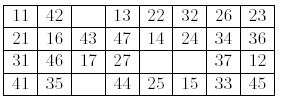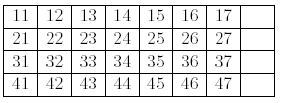poj2046
| Time Limit: 5000MS | Memory Limit: 65536K | |
| Total Submissions: 1829 | Accepted: 829 |
Description
You have 28 cards labeled with two-digit numbers. The first digit (from 1 to 4) represents the suit of the card, and the second digit (from 1 to 7) represents the value of the card.
First, you shu2e the cards and lay them face up on the table in four rows of seven cards, leaving a space of one card at the extreme left of each row. The following shows an example of initial layout. 
Next, you remove all cards of value 1, and put them in the open space at the left end of the rows: "11" to the top row, "21" to the next, and so on.
Now you have 28 cards and four spaces, called gaps, in four rows and eight columns. You start moving cards from this layout. 
At each move, you choose one of the four gaps and fill it with the successor of the left neighbor of the gap. The successor of a card is the next card in the same suit, when it exists. For instance the successor of "42" is "43", and "27" has no successor.
In the above layout, you can move "43" to the gap at the right of "42", or "36" to the gap at the right of "35". If you move "43", a new gap is generated to the right of "16". You cannot move any card to the right of a card of value 7, nor to the right of a gap.
The goal of the game is, by choosing clever moves, to make four ascending sequences of the same suit, as follows. 
Your task is to find the minimum number of moves to reach the goal layout.
Input
Each layout consists of five lines - a blank line and four lines which represent initial layouts of four rows. Each row has seven two-digit numbers which correspond to the cards.
Output
Sample Input
4 12 13 14 15 16 17 21
22 23 24 25 26 27 31
32 33 34 35 36 37 41
42 43 44 45 46 47 11 26 31 13 44 21 24 42
17 45 23 25 41 36 11
46 34 14 12 37 32 47
16 43 27 35 22 33 15 17 12 16 13 15 14 11
27 22 26 23 25 24 21
37 32 36 33 35 34 31
47 42 46 43 45 44 41 27 14 22 35 32 46 33
13 17 36 24 44 21 15
43 16 45 47 23 11 26
25 37 41 34 42 12 31
Sample Output
0
33
60
-1
Source
问最少需要几次操作,达到图片3的状态
#include<cstdio>
#include<cstring>
using namespace std;
const int M=;
struct data
{
char s[],e[],p[];
int ans;
}w[];
int id[M],ans;
inline int BKDRHash(char *str)
{
int hash=,q=;
while(++q<)hash=hash*+(*str++);
return((hash&0x7FFFFFFF)%M);
}
inline void insert(char *c,int i)
{
int x=BKDRHash(c);
while(id[x]>=)
{
x+=;
if(x>=M)x%=M;
}
id[x]=i;
}
inline bool cmp(char *p,char *q)
{
for(int i=;i<;++i,++p,++q)
if(*p!=*q)return ;
return ;
}
inline int find(char *c)
{
int x=BKDRHash(c);
while(id[x]>=&&cmp(c,w[id[x]].s))
{
x+=;
if(x>=M)x%=M;
}
return id[x];
}
inline void get(char &a)
{
char ch=getchar();
while (ch<''||ch>'')ch=getchar();
for(a=;ch>=''&&ch<='';ch=getchar())a=a*+ch-;
if((a==)||(a==)||(a==)||(a==))a=;
}
inline void cpy(char *p,char *q,int n)
{
for(int i=;i<n;++i,++p,++q)*p=*q;
}
inline int bfs()
{
int l=,r=,rr=,i,k,s,p,e;
do
{
cpy(w[rr].s,w[++l].s,);
for(i=;i<;++i)
if(w[l].s[(e=w[l].e[i])-]%<&&w[l].s[e-]>)
{
w[rr].s[e]=s=w[l].s[e-]+,w[rr].s[p=w[l].p[s]]=;
if((k=find(w[rr].s))<)
{
++r,++rr,cpy(w[r].e,w[l].e,),cpy(w[r].p,w[l].p,);
w[r].e[i]=p,w[r].p[s]=e,w[r].ans=w[l].ans+;
insert(w[r].s,r);
cpy(w[rr].s,w[l].s,);
}
else w[rr].s[p]=s,w[rr].s[e]=;
if(!k)return w[l].ans+;
}
}while(l<r);
return -;
}
int main()
{
int n,i,j,k;
for(i=;i<;i+=)
for(j=;j<;++j)w[].s[i+j]=(i/+)*+j+;
scanf("%d",&n);
while(n--)
{
memset(id,-,sizeof(id));
insert(w[].s,);
for(i=;i<;i+=)
for(w[].s[i]=(i/+)*+,j=;j<;++j)get(w[].s[i+j]),w[].p[w[].s[i+j]]=i+j;
if(!find(w[].s))printf("0\n");
else
{
for(k=i=;i<;i+=)
for(j=;j<;++j)
if(!w[].s[i+j])w[].e[k++]=i+j;
w[].ans=;
insert(w[].s,);
printf("%d\n",bfs());
}
}
return ;
}
最新文章
- 文件IO操作..修改文件的只读属性
- floating IP 原理分析 - 每天5分钟玩转 OpenStack(107)
- 【算法】PHP实现冒泡排序和快速排序--防遗忘
- Struts2 internationalization(国际化)
- Jquery.Datatables td宽度太长的情况下,自动换行
- jqxGrid 绑定格式化
- oracle 存储过程发邮件
- HDU 2993 MAX Average Problem dp斜率优化
- 字符串的妙用之拼出花样的sql
- Mongodb 3.4 + Centos6.5 配置 + mysql.sql转为csv 或 json导入和导出Mongo (64位系统)
- Memcached的安装与简单使用
- office2013使用空格符
- 全排列递归算法(元素有重复与无重复,C++实现)
- 我对PMO的理解(持续更新)
- MYSQL分组合并函数
- 使用JavaConfig和注解方式实现零xml配置的Spring MVC项目
- Android UIAutomator 定位
- UVa 11292 勇者斗恶龙
- [js]变量与数据类型篇
- 2018 Multi-University Training Contest 4-Glad You Came(hdu 6356)